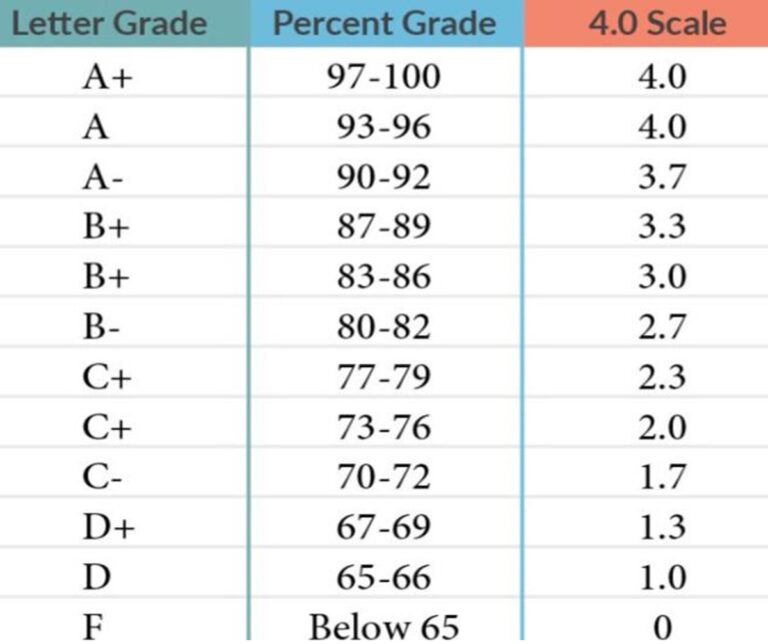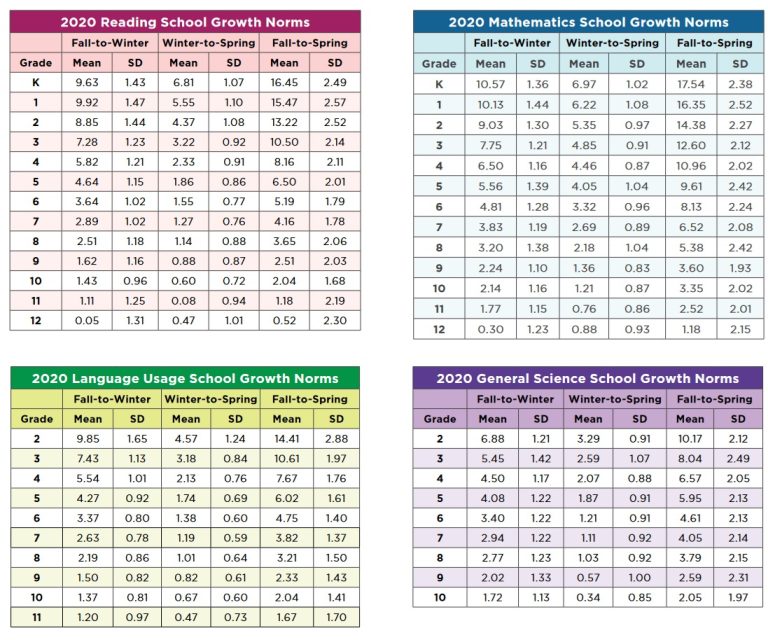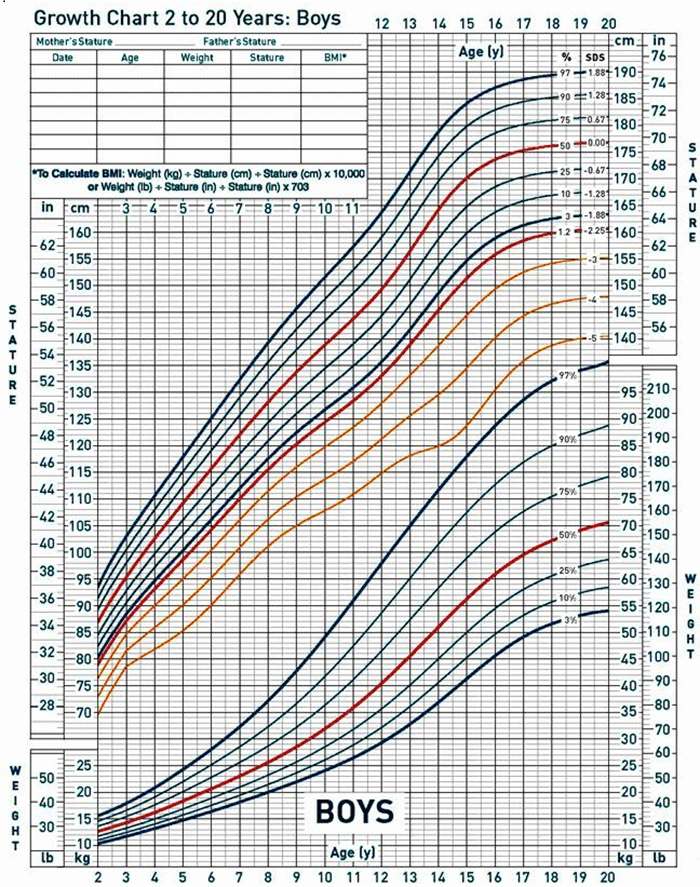What is the Average Height for a 14 Year Old Boy and Girl? (Age 1-10, 11, 12, 13, 14, 15 Height and Weight)
What is the Average Height and Weight for a Boy and Girl According to Age?
When do boys and girls stop growing, what is the average height and weight for your child’s age, and how tall will your child likely be? Get the answers here.
Growth isn’t just about getting taller or heavier—it’s about how your body develops over time. A child’s brain grows fast in the first five years, reaching 90% of its adult size. Different body parts grow at different rates too; for example, the head is nearly fully grown by age 1. As kids grow, their bodies become more balanced, and by around 16-18 years old, most of their growth is done as their bones stop growing.
Doctors use growth charts to check if a child is growing normally. Here’s a look at average height and weight ranges of children in the US, based on data from the CDC.gov in inches (You can see the numbers in centimeters and kilogram below that chart):
Average Height for a Boy and a Girl in Feet (Inches) and Average Weight (Pounds).
| Age | Height – Females | Height – Males | Weight – Females | Weight – Males |
|---|---|---|---|---|
| 1 | 27 to 31 inches | 28 to 32 inches | 15 to 20 pounds | 17 to 21 pounds |
| 2 | 31.5 to 36 inches | 32 to 37 inches | 22 to 32 pounds | 24 to 34 pounds |
| 3 | 34.5 to 40 inches | 35.5 to 40.5 inches | 26 to 38 pounds | 26 to 38 pounds |
| 4 | 37 to 42.5 inches | 37.5 to 43 inches | 28 to 44 pounds | 30 to 44 pounds |
| 5 | 40 to 45 inches | 40 to 45 inches | 34 to 47 pounds | 34 to 47 pounds |
| 6 | 42 to 49 inches | 42 to 49 inches | 36 to 60 pounds | 36 to 60 pounds |
| 7 | 45 to 51 inches | 45 to 51 inches | 41 to 68 pounds | 41 to 67 pounds |
| 8 | 47 to 54 inches | 47 to 54 inches | 44 to 80 pounds | 46 to 78 pounds |
| 9 | 49 to 56 inches | 49 to 56 inches | 49 to 90 pounds | 50 to 88 pounds |
| 10 | 50 to 59 inches | 50.5 to 59 inches | 54 to 106 pounds | 54 to 102 pounds |
| 11 | 52 to 61 inches | 52 to 61 inches | 59 to 116 pounds | 60 to 114 pounds |
| 12 | 55 to 64 inches | 54 to 63.5 inches | 68 to 136 pounds | 66 to 130 pounds |
| 13 | 57 to 65 inches | 57 to 65 inches | 75 to 145 pounds | 75 to 145 pounds |
| 14 | 59 to 67.5 inches | 59 to 69.5 inches | 84 to 160 pounds | 84 to 160 pounds |
| 15 | 60 to 68 inches | 61 to 71 inches | 90 to 165 pounds | 95 to 170 pounds |
| 16 | 60 to 68 inches | 63 to 73 inches | 94 to 172 pounds | 104 to 186 pounds |
| 17 | 60 to 68.5 inches | 64 to 74 inches | 98 to 176 pounds | 112 to 198 pounds |
| 18 | 60 to 68.5 inches | 65 to 74 inches | 100 to 178 pounds | 116 to 202 pounds |
Please note, that we have used an ‘average range’ for height and weight. For the precise Mean Average (the height of a child in the 50th percentile of that age, please see the data further down this page.
We have also converted the chart Centimeters and Kilogram, below:
Average Height for a Boy and a Girl in Cm and Average Weight in Kilogram.
| Age | Height – Females (cm) | Height – Males (cm) | Weight – Females (kg) | Weight – Males (kg) |
|---|---|---|---|---|
| 1 | 68.6-78.7 cm | 71.1-81.3 cm | 6.8-9.1 kg | 7.7-9.5 kg |
| 2 | 80.0-91.4 cm | 81.3-94.0 cm | 10.0-14.5 kg | 10.9-15.4 kg |
| 3 | 87.6-101.6 cm | 90.2-102.9 cm | 11.8-17.2 kg | 11.8-17.2 kg |
| 4 | 94.0-108.0 cm | 95.2-109.2 cm | 12.7-20.0 kg | 13.6-20.0 kg |
| 5 | 101.6-114.3 cm | 101.6-114.3 cm | 15.4-21.3 kg | 15.4-21.3 kg |
| 6 | 106.7-124.5 cm | 106.7-124.5 cm | 16.3-27.2 kg | 16.3-27.2 kg |
| 7 | 114.3-129.5 cm | 114.3-129.5 cm | 18.6-30.8 kg | 18.6-30.4 kg |
| 8 | 119.4-137.2 cm | 119.4-137.2 cm | 20.0-36.3 kg | 20.9-35.4 kg |
| 9 | 124.5-142.2 cm | 124.5-142.2 cm | 22.2-40.8 kg | 22.7-39.9 kg |
| 10 | 127.0-149.9 cm | 128.3-149.9 cm | 24.5-48.1 kg | 24.5-46.3 kg |
| 11 | 132.1-154.9 cm | 132.1-154.9 cm | 26.8-52.6 kg | 27.2-51.7 kg |
| 12 | 139.7-162.6 cm | 137.2-161.3 cm | 30.8-61.7 kg | 29.9-59.0 kg |
| 13 | 144.8-165.1 cm | 144.8-165.1 cm | 34.0-65.8 kg | 34.0-65.8 kg |
| 14 | 149.9-171.5 cm | 149.9-176.5 cm | 38.1-72.6 kg | 38.1-72.6 kg |
| 15 | 152.4-172.7 cm | 154.9-180.3 cm | 40.8-74.8 kg | 43.1-77.1 kg |
| 16 | 152.4-172.7 cm | 160.0-185.4 cm | 42.6-78.0 kg | 47.2-84.4 kg |
| 17 | 152.4-174.0 cm | 162.6-187.9 cm | 44.5-79.8 kg | 50.8-89.8 kg |
| 18 | 152.4-174.0 cm | 165.1-188.0 cm | 45.4-80.7 kg | 52.6-91.6 kg |
When Do Boys Stop Growing?
Boys typically stop growing between the ages of 16 and 18, although growth can continue slightly into their early 20s in some cases. During puberty, which usually starts between the ages of 12 and 14, boys experience rapid growth spurts. These growth spurts are typically more intense and occur later than in girls. By around 18 years old, most boys will have reached their final adult height as the growth plates in their bones close. However, other factors like genetics, nutrition, and overall health can slightly influence when a boy stops growing.
When Do Girls Stop Growing?
Girls usually stop growing earlier than boys, typically around the age of 16. Most girls experience the majority of their growth during puberty, which generally begins between the ages of 10 and 12. Girls tend to reach their final height by the age of 16, or even earlier, as their growth plates in the bones close after their first menstrual period. Growth slows down significantly after this, with only minor increases in height occurring after the age of 14-16. Like boys, factors such as genetics and nutrition can affect the exact age at which growth stops.
Chart of Average Height According to Age for Boys and Girls – Cm and Kg.
This chart shows the average (median) height of the boys and girls in Centimeters and Weight in Kilograms. Height and Weight on the Y-Axis and age on the X-axis. All numbers are the median average (50th percentile). Notice how girls’ normal growth plateau around the year 14, whereas boys’ growth tend to continue for a few more years.
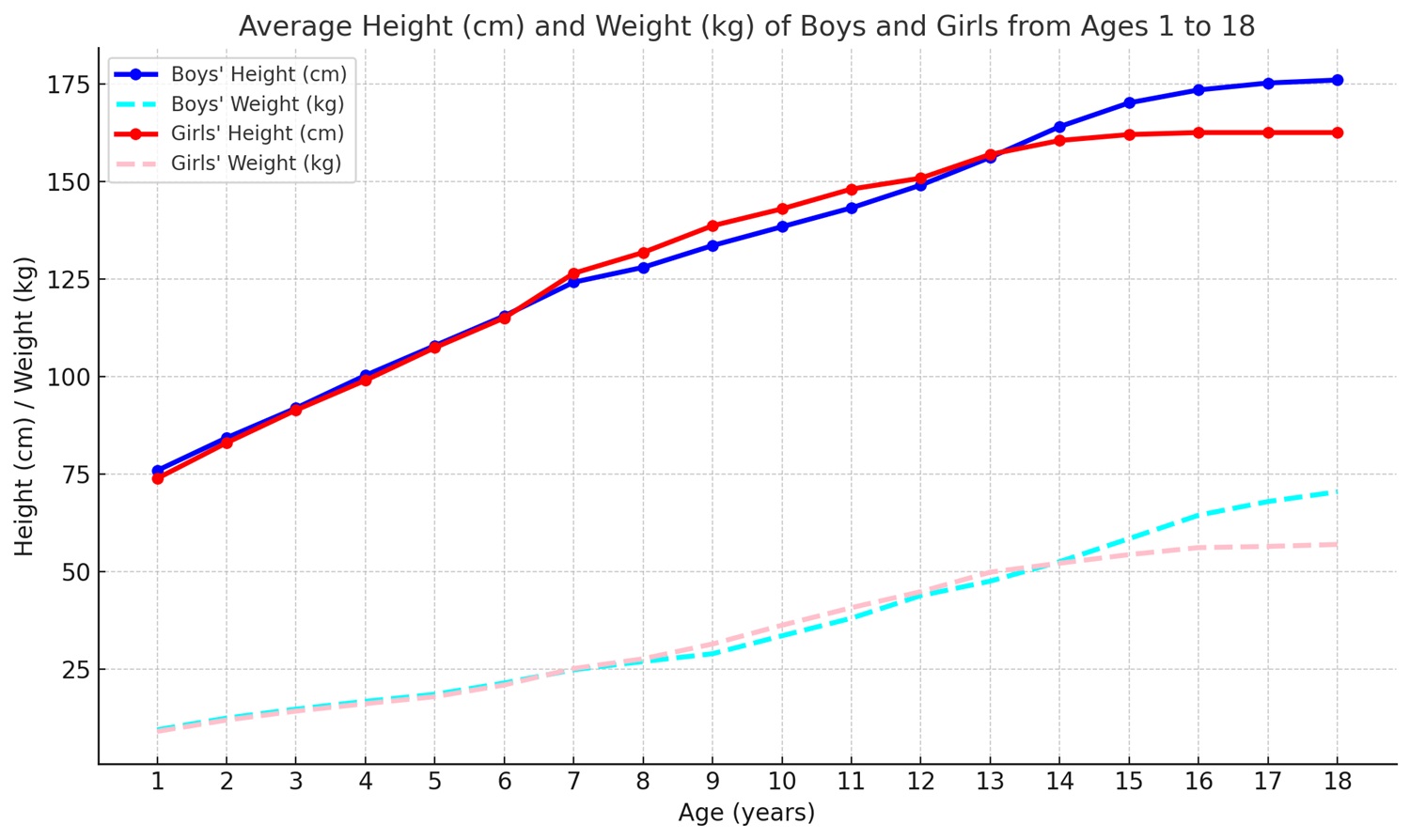
Chart of Average Height According to Age for Boys and Girls – Inches and Pounds.
This is the same chart as above but with inches and pounds on the Y-axis, instead of centimeters and kilogram.
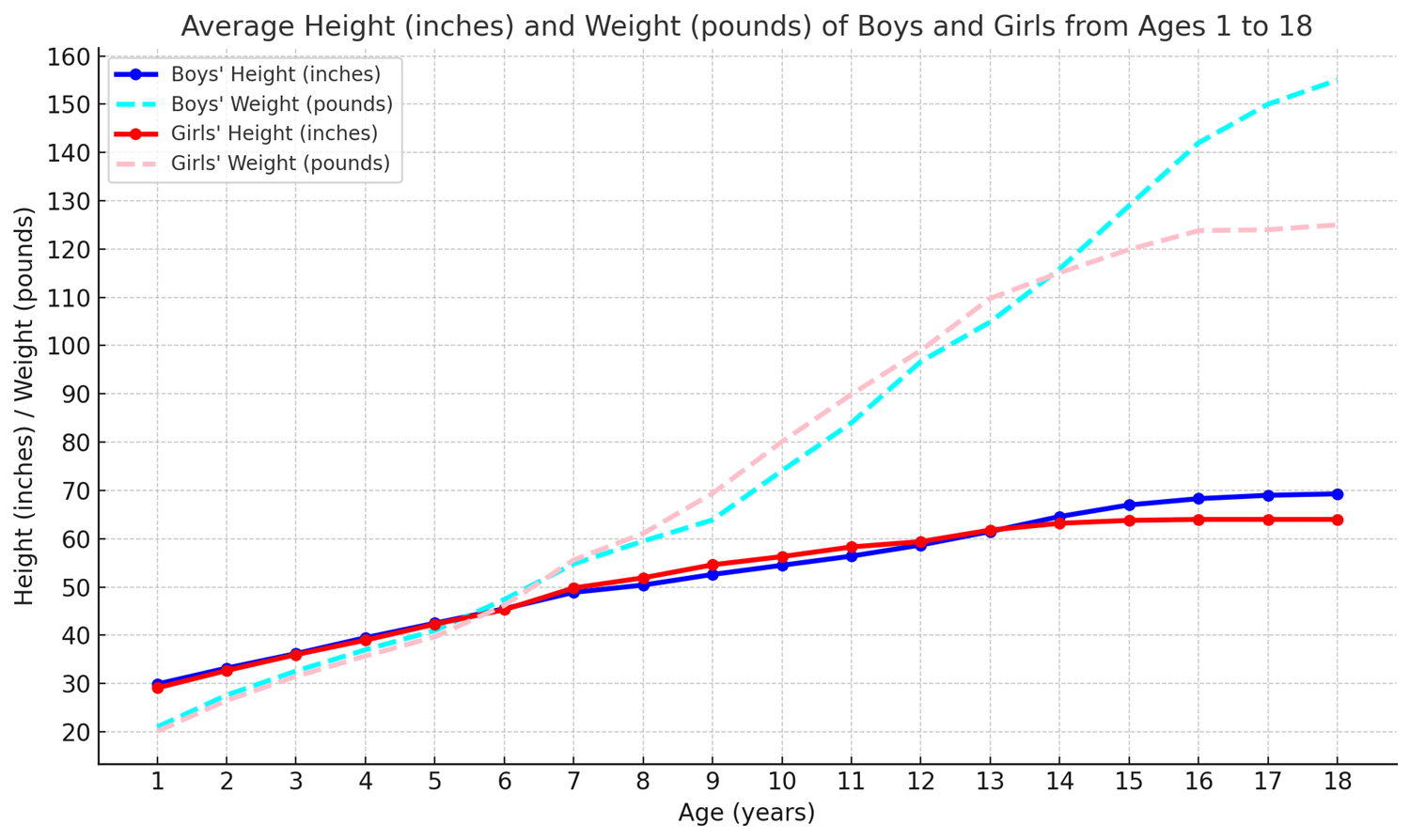
Chart of Childrens’ Height According to Age – 5th, 50th and 95th Percentile.
On this chart, we have added the 5th and 95th percentile in boys’ and girls’ height for each age, to compare with the 50th percentile (median average).
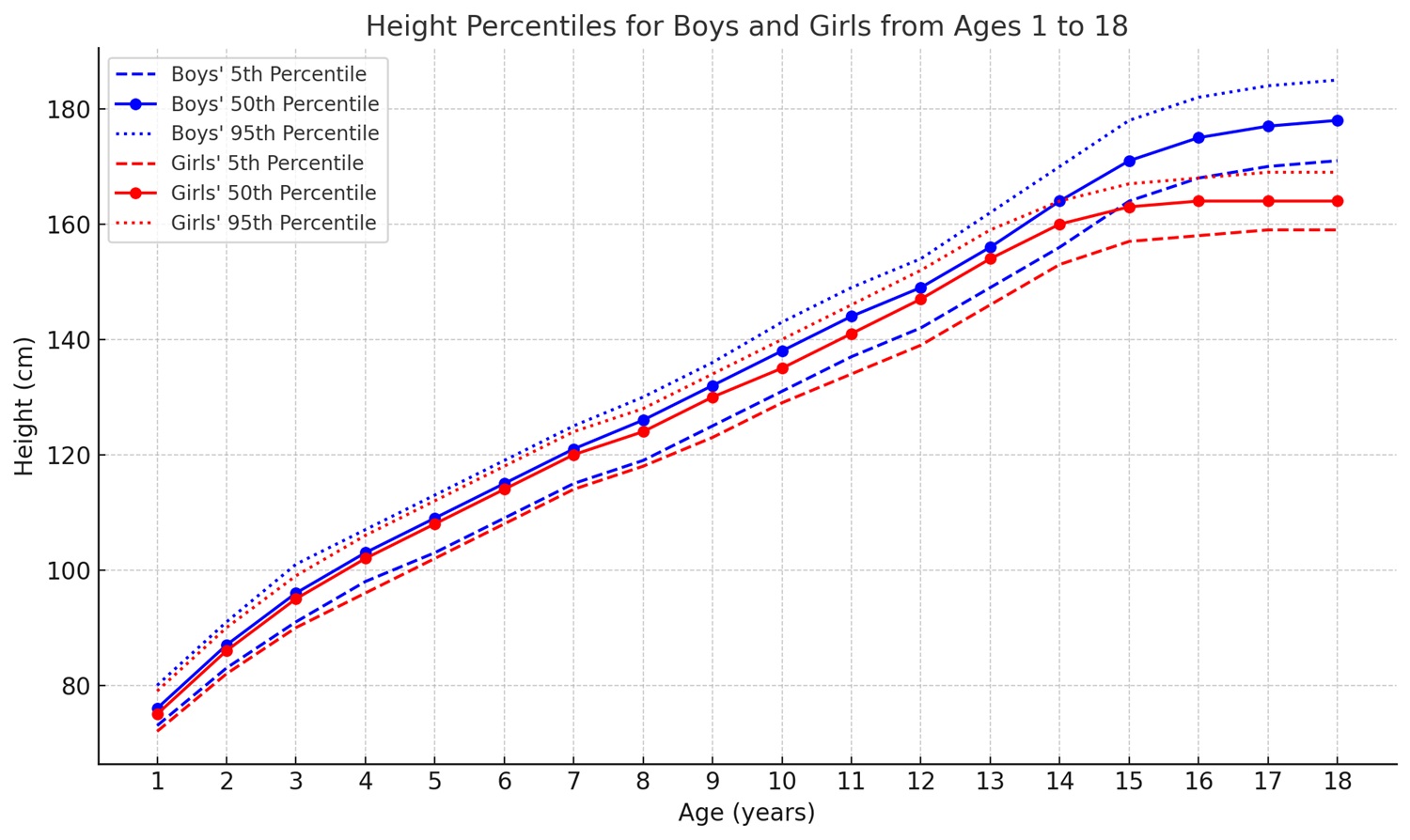
How to read the chart:
- 5th Percentile: Boys in the 5th percentile are shorter than 95% of boys in their age group. Starting at around 73 cm at age 1, boys in this group steadily grow to about 171 cm by age 18. Their growth accelerates between ages 12 and 16, reflecting the typical onset of puberty.
- 50th Percentile: This represents the median or average height for boys. They start at about 76 cm at age 1 and grow to about 178 cm by age 18. Growth is relatively steady until puberty, with rapid height increases between ages 12 and 16. Growth slows considerably after age 16.
- 95th Percentile: Boys in the 95th percentile are taller than 95% of boys their age. These boys start at 80 cm at age 1 and reach about 185 cm by age 18. They experience the same rapid growth during puberty but begin from a higher base height.
Average Height of Boys and Girls According to Age (in Inches and Centimeters).
The following answers are based on the median average (the 50th percentile) height of children in the United States:
What is the Average Height for an 18 Year Old Boy?
The average height for an 18-year-old boy is around 69.5 inches (176.5 cm). At this age, most boys have reached their final adult height as growth plates have typically fused, although minimal growth may still occur for some.
What is the Average Height for an 18 Year Old Girl?
For an 18-year-old girl, the average height is 64 inches (162.5 cm). Girls generally stop growing earlier than boys, often by age 16, as their growth plates close earlier.
What is the Average Height for a 17 Year Old Boy?
At 17, boys average 69 inches (175 cm). Growth is nearing completion for most, though some may continue to grow slightly until their early twenties.
What is the Average Height for a 17 Year Old Girl?
For 17-year-old girls, the average height is 63.8 inches (162 cm), typically similar to their final adult height, as most girls stop growing between 16 and 17 years old.
What is the Average Height for a 16 Year Old Boy?
The average height for a 16-year-old boy is 68.3 inches (173.5 cm). By this age, many boys have experienced the bulk of their growth spurt but may still grow a few more inches.
What is the Average Height for a 16 Year Old Girl?
For 16-year-old girls, the average height is 63.9 inches (162.5 cm), which is usually their final adult height.
What is the Average Height for a 15 Year Old Boy?
At 15 years old, boys typically average 67 inches (170.2 cm). This age is marked by rapid growth as many boys are in the middle or nearing the end of their growth spurts.
What is the Average Height for a 15 Year Old Girl?
For 15-year-old girls, the average height is 63.8 inches (162.1 cm). By this age, most girls have reached their near-final height or are very close to it, as they tend to stop growing earlier than boys.
What is the Average Height for a 14 Year Old Boy?
The average height for 14-year-old boys is 64.6 inches (164.1 cm). This period is a significant time of growth for many boys, with puberty driving much of the increase in height.
What is the Average Height for a 14 Year Old Girl?
For 14-year-old girls, the average height is 63.2 inches (160.5 cm). At this age, many girls have already slowed down in terms of growth, though small increases in height may still occur before they reach their final adult height.
What is the Average Height for a 13 Year Old Boy?
At 13, boys average 61.5 inches (156.2 cm). This is a common age for boys to begin experiencing their major growth spurts as they enter puberty.
What is the Average Height for a 13 Year Old Girl?
For 13-year-old girls, the average height is 61.8 inches (157 cm). By this age, most girls are nearing their final adult height, as growth begins to slow significantly.
What is the Average Height for a 12 Year Old Boy?
The average height for 12-year-old boys is 58.7 inches (149 cm). Many boys at this age are just beginning to hit their growth spurts, with puberty setting in for most.
What is the Average Height for a 12 Year Old Girl?
The average height for a 12-year-old girl is 59.4 inches (151 cm). By this age, girls’ growth begins to slow as they approach their final adult height.
What is the Average Height for an 11 Year Old Boy?
For 11-year-old boys, the average height is 56.4 inches (143.3 cm). At this age, boys are growing steadily, with major growth spurts still on the horizon.
What is the Average Height for an 11 Year Old Girl?
The average height for an 11-year-old girl is 58.3 inches (148 cm). Girls at this age are typically taller than boys, as their growth spurts often occur earlier due to earlier onset of puberty.
What is the Average Height for a 10 Year Old Boy?
At age 10, the average height for boys is 54.5 inches (138.4 cm). Boys at this age grow steadily, though they haven’t yet hit their major growth spurts, which typically occur in the coming years.
What is the Average Height for a 10 Year Old Girl?
For girls aged 10, the average height is 56.3 inches (143 cm). Girls continue to grow steadily at this age but will soon begin to slow down as they approach puberty.
What is the Average Height for a 9 Year Old Boy?
At 9 years old, boys average 52.6 inches (133.6 cm). Boys tend to experience gradual growth at this age, with the major growth spurts still to come during puberty.
What is the Average Height for a 9 Year Old Girl?
For 9-year-old girls, the average height is 54.6 inches (138.7 cm). At this age, girls are growing slightly faster than boys, as puberty is just around the corner for many.
What is the Average Height for an 8 Year Old Boy?
The average height for 8-year-old boys is 50.4 inches (128 cm). Growth is steady at this age but not as rapid as it will be during the upcoming puberty years.
What is the Average Height for an 8 Year Old Girl?
For 8-year-old girls, the average height is 51.9 inches (131.8 cm). Growth remains consistent at this age, but it will soon pick up as puberty approaches.
What is the Average Height for a 7 Year Old Boy?
At age 7, boys have an average height of 48.9 inches (124.2 cm). Growth is relatively slow but steady before the onset of puberty-related growth spurts.
What is the Average Height for a 7 Year Old Girl?
The average height for 7-year-old girls is 49.8 inches (126.5 cm). Girls at this age are growing consistently, but puberty is still a few years away.
What is the Average Height for a 6 Year Old Boy?
For 6-year-old boys, the average height is 45.5 inches (115.6 cm). Growth at this age is steady, as boys are still a few years away from their major growth spurts.
What is the Average Height for a 6 Year Old Girl?
For 6-year-old girls, the average height is 45.3 inches (115 cm). Girls and boys tend to be similar in height at this age, with no significant differences yet.
What is the Average Height for a 5 Year Old Boy?
At 5 years old, boys average 42.5 inches (108 cm). Growth remains steady before the onset of more significant growth phases during puberty.
What is the Average Height for a 5 Year Old Girl?
For 5-year-old girls, the average height is 42.3 inches (107.5 cm). Growth at this age is consistent for both boys and girls.
According to data from CDC.gov, published in the year 2001.
Average Weight of Boys and Girls According to Age (in Pounds and Kilograms).
According to data from CDC.gov, published in the year 2001. The data are the median average (the 50th percentile) weight of children in the United States:
What is the Average Weight for an 18 Year Old Boy?
The median weight for an 18-year-old boy is 155 pounds (70.5 kg). By this age, most boys have reached their final adult weight, though minor fluctuations may still occur depending on factors like lifestyle and diet.
What is the Average Weight for an 18 Year Old Girl?
For 18-year-old girls, the median weight is 125 pounds (56.7 kg). Most girls stop gaining significant weight by this age, having already reached their adult body composition.
What is the Average Weight for a 17 Year Old Boy?
At 17 years old, the median weight for boys is 150 pounds (68 kg). This is close to their final adult weight, with most boys having completed the bulk of their physical development by this age.
What is the Average Weight for a 17 Year Old Girl?
For 17-year-old girls, the median weight is 124 pounds (56.2 kg). Most girls have stabilized in terms of weight gain by this age, as they have generally reached their adult body size.
What is the Average Weight for a 16 Year Old Boy?
According to CDC data, the median weight for a 16-year-old boy is 142 pounds (64.4 kg). By this age, most boys have reached a steady growth pattern, though weight changes may continue based on factors like diet and physical activity.
What is the Average Weight for a 16 Year Old Girl?
For 16-year-old girls, the median weight is 123.8 pounds (56.2 kg). Girls generally reach their adult weight earlier than boys, as growth in height slows around this age.
What is the Average Weight for a 15 Year Old Boy?
At 15 years old, the median weight for boys is 129 pounds (58.5 kg). This is a time when many boys are continuing to gain weight as part of their ongoing physical development.
What is the Average Weight for a 15 Year Old Girl?
For 15-year-old girls, the average weight is 119.9 pounds (54.4 kg). By this age, most girls have reached near their final weight, as physical growth slows significantly.
What is the Average Weight for a 14 Year Old Boy?
The median weight for a 14-year-old boy is 115.9 pounds (52.6 kg). This period marks significant physical development as boys gain weight, especially during their puberty years.
What is the Average Weight for a 14 Year Old Girl?
For 14-year-old girls, the average weight is 115.1 pounds (52.2 kg). By this age, many girls have slowed down in terms of weight gain, though some small increases may still occur.
What is the Average Weight for a 13 Year Old Boy?
At 13 years old, boys have a median weight of 104.9 pounds (47.6 kg). This is often the age when boys begin their major physical growth spurts, which are accompanied by weight gain.
What is the Average Weight for a 13 Year Old Girl?
For 13-year-old girls, the median weight is 109.8 pounds (49.9 kg). By this age, most girls are nearing their adult weight, with weight gain slowing significantly.
What is the Average Weight for a 12 Year Old Boy?
The average weight for 12-year-old boys is 96.7 pounds (43.9 kg). At this age, boys are just beginning to hit their growth spurts, leading to increases in weight.
What is the Average Weight for a 12 Year Old Girl?
The median weight for a 12-year-old girl is 99 pounds (44.9 kg). By this age, girls’ weight gain is beginning to slow as they approach their final adult weight.
What is the Average Weight for an 11 Year Old Boy?
For boys aged 11, the average weight is 84 pounds (38.1 kg). Boys are still growing steadily, and weight gain will continue through adolescence.
What is the Average Weight for an 11 Year Old Girl?
The median weight for an 11-year-old girl is 89.9 pounds (40.8 kg). Girls at this age are typically heavier than boys due to their earlier onset of puberty and growth spurts.
What is the Average Weight for a 10 Year Old Boy?
The average weight for a 10-year-old boy is 74.1 pounds (33.6 kg). Boys continue growing steadily, though their major growth spurts are still ahead.
What is the Average Weight for a 10 Year Old Girl?
For girls aged 10, the median weight is 80.1 pounds (36.3 kg). Girls grow consistently at this age, but their rate of weight gain will soon slow as puberty progresses.
What is the Average Weight for a 9 Year Old Boy?
At 9 years old, boys have a median weight of 63.9 pounds (29 kg). Growth at this age is gradual, and weight gain is consistent.
What is the Average Weight for a 9 Year Old Girl?
For 9-year-old girls, the average weight is 69.4 pounds (31.5 kg). Girls tend to grow faster than boys at this age, as their physical development often begins earlier.
What is the Average Weight for an 8 Year Old Boy?
The median weight for an 8-year-old boy is 59.5 pounds (27 kg). Growth at this stage is steady, and boys are preparing for the rapid changes of puberty.
What is the Average Weight for an 8 Year Old Girl?
For 8-year-old girls, the average weight is 61.1 pounds (27.7 kg). Girls grow steadily, but they will begin to gain more weight as puberty approaches.
What is the Average Weight for a 7 Year Old Boy?
At 7 years old, boys have a median weight of 54.8 pounds (24.9 kg). Growth is relatively slow but consistent before the onset of puberty-related weight gain.
What is the Average Weight for a 7 Year Old Girl?
The average weight for 7-year-old girls is 55.6 pounds (25.2 kg). Growth at this age is steady, though puberty is still a few years away.
What is the Average Weight for a 6 Year Old Boy?
The median weight for 6-year-old boys is 47.4 pounds (21.5 kg). Boys are growing steadily in preparation for the rapid physical changes to come.
What is the Average Weight for a 6 Year Old Girl?
For 6-year-old girls, the median weight is 46.2 pounds (21 kg). Boys and girls tend to be fairly similar in weight at this age, as major differences have yet to emerge.
What is the Average Weight for a 5 Year Old Boy?
At 5 years old, the average weight for boys is 41 pounds (18.6 kg). Growth remains steady, with boys gaining weight consistently before the onset of puberty.
What is the Average Weight for a 5 Year Old Girl?
For 5-year-old girls, the median weight is 39.7 pounds (18 kg). Boys and girls at this age have similar weights, as growth is fairly consistent for both.
What is the Average Weight for a 4 Year Old Boy?
The median weight for a 4-year-old boy is 37 pounds (16.8 kg). Boys at this age experience steady growth, with consistent weight gain as they develop through early childhood.
What is the Average Weight for a 4 Year Old Girl?
For 4-year-old girls, the median weight is 35.7 pounds (16.2 kg). Girls grow steadily through early childhood, with weight gain continuing at a similar rate to boys.
What is the Average Weight for a 3 Year Old Boy?
At 3 years old, boys have a median weight of 32.6 pounds (14.8 kg). Weight gain is steady but not as rapid as it will be during later growth spurts.
What is the Average Weight for a 3 Year Old Girl?
For 3-year-old girls, the average weight is 31.5 pounds (14.3 kg). At this age, girls and boys maintain similar growth patterns in terms of weight.
What is the Average Weight for a 2 Year Old Boy?
The median weight for a 2-year-old boy is 27.6 pounds (12.5 kg). Growth in the toddler years is steady, but major physical changes occur later in childhood.
What is the Average Weight for a 2 Year Old Girl?
For 2-year-old girls, the median weight is 26.5 pounds (12 kg). Both boys and girls grow at similar rates during the toddler years.
What is the Average Weight for a 1 Year Old Boy?
At 1 year old, boys have a median weight of 21 pounds (9.5 kg). Growth is rapid during the first year, as boys experience significant physical changes.
What is the Average Weight for a 1 Year Old Girl?
For 1-year-old girls, the median weight is 20.1 pounds (9.1 kg). Girls and boys tend to grow at similar rates during their first year of life, though differences in growth patterns emerge later in childhood.
According to data from CDC.gov, sourced in the year 2001.
Growth Spurts in Children.
Growth spurts are periods of rapid physical growth that occur in children, most notably during infancy and adolescence. During these phases, children can grow significantly in height over a short period of time. For girls, the biggest growth spurt typically occurs between ages 10 and 14, coinciding with the start of puberty. Boys tend to experience their growth spurt a bit later, usually between ages 12 and 16. Growth spurts are accompanied by an increase in appetite, changes in sleep patterns, and sometimes mood swings, as the body adapts to its rapid development.
How to Increase Height in Children with Nutrition.
While genetics play a significant role in determining height, proper nutrition is essential for ensuring that a child reaches their full growth potential. Nutrient-rich diets that are high in protein, calcium, vitamin D, and other essential vitamins and minerals can support healthy bone development and growth. Foods such as dairy products, lean meats, fish, eggs, fruits, and vegetables are important for supplying the body with the necessary nutrients for growth. Staying hydrated and maintaining a balanced diet can also help maximize a child’s height during their growth years. Additionally, adequate sleep and regular physical activity are crucial for overall growth.
How to Increase Height with Medicine.
There are no medicines that can significantly increase height once the growth plates in bones have closed, which typically happens by the end of puberty. However, in rare cases where a child is significantly shorter than expected due to a growth hormone deficiency, a doctor may prescribe growth hormone therapy. This treatment is only used for specific medical conditions and must be carefully monitored by a physician. It involves administering synthetic growth hormones to stimulate growth in children whose growth is delayed or stunted due to hormonal issues. It’s important to note that growth hormone therapy is not effective for children who do not have a hormone deficiency, and there are risks involved with its use.
Height Differences Based on Race and Ethnicity
Height can vary significantly depending on racial and ethnic backgrounds due to genetic and environmental factors. Here are some general observations:
- Caucasian (European/American) Children: Caucasian children in the U.S. and Europe tend to have slightly higher average heights compared to other ethnic groups. For example, boys and girls in Western countries like the U.S. and the Netherlands are generally taller than the global average.
- Asian Children: Children from East Asian countries such as Japan, China, and South Korea are typically shorter on average compared to their Western counterparts, although there has been a significant increase in height in recent decades due to improved nutrition and health standards. Southeast Asian children from countries like Indonesia, the Philippines, and Thailand tend to be on the shorter side as well.
- African and African American Children: Children of African descent often show higher rates of growth during their growth spurts. African American children, in particular, may experience earlier growth spurts compared to their Caucasian peers, leading to early height gains.
- Latino Children: Children from Latin American countries like Mexico, Brazil, and Argentina often have heights that vary by region and country. Factors such as nutrition, economic conditions, and health care access play a significant role. In some countries, children are slightly shorter than in Western Europe or North America, but this is changing with better living standards.
- Children from Nordic and Northern European Countries: Countries such as the Netherlands, Denmark, and Norway have some of the tallest populations in the world. Dutch children, for example, are consistently among the tallest globally. Nutrition and genetics play a key role in these countries’ height averages.
Height Differences Based on Country (Adults).
Average height varies not only by race but also by country, as factors like diet, healthcare access, and lifestyle play critical roles in growth. Some countries have populations that are notably taller or shorter than the global average:
- Netherlands: Dutch people are among the tallest in the world, with Dutch men averaging around 6 feet (183 cm) tall. Dutch women are also tall, averaging about 5 feet 7 inches (170 cm). The tall height of the Dutch is often attributed to high standards of living, quality healthcare, and nutrition.
- United States: In the U.S., the average height for men is around 5 feet 9 inches (175 cm) and for women, about 5 feet 4 inches (162 cm). Height in the U.S. varies significantly across different ethnic groups and socioeconomic classes.
- Japan: Historically, Japan had shorter average heights compared to Western countries, but in recent decades, Japanese children have grown significantly taller due to improvements in nutrition and healthcare. The average height for Japanese men is now around 5 feet 7 inches (170 cm), while women average 5 feet 2 inches (158 cm).
- India: Indian children are typically shorter on average compared to Western counterparts. Factors such as malnutrition, healthcare access, and socioeconomic conditions have affected average height. Indian men average around 5 feet 5 inches (165 cm), and women average around 5 feet (152 cm).
- Brazil: In Brazil, height is influenced by the diversity of the population, with averages around 5 feet 8 inches (173 cm) for men and 5 feet 4 inches (162 cm) for women. Improvements in nutrition and healthcare have also led to a gradual increase in height.
- South Korea: South Korea has seen dramatic changes in average height over the past several decades. Improved healthcare and a focus on balanced diets have contributed to a significant increase in average height, with men averaging around 5 feet 9 inches (175 cm) and women 5 feet 4 inches (162 cm).
Environmental and Economic Factors Affecting Height in Children.
In addition to genetics and race, environmental factors such as nutrition, healthcare, and living standards also play crucial roles in determining a child’s height. Children growing up in countries with access to high-quality healthcare, well-balanced diets, and a healthy lifestyle are more likely to reach their full height potential. Conversely, in areas with high rates of malnutrition, poor healthcare, and challenging living conditions, children may experience stunted growth.
Growth spurts and average height in children are influenced by a combination of race, genetics, environmental factors, and geography. Countries with improved living standards, healthcare, and nutrition generally see taller populations, while other regions may have shorter average heights due to various socio-economic factors.
How Tall Will I Be?
Determining a child’s future height can be estimated using the heights of the mother and father. While genetics play the biggest role in predicting height, other factors such as nutrition, health, and environment also influence growth. There are some general methods that can give you an estimate of a child’s potential adult height.
Mid-Parental Height Formula:
One of the most common ways to estimate a child’s height is the mid-parental height formula, which takes into account the heights of both parents. Here’s how it works:
For Boys:
- Add the mother’s height and the father’s height (in inches or centimeters).
- Add 5 inches (13 cm) to the total.
- Divide the result by 2.
For Girls:
- Add the mother’s height and the father’s height (in inches or centimeters).
- Subtract 5 inches (13 cm) from the total.
- Divide the result by 2.
Example:
- Father’s height: 6 feet (72 inches / 183 cm)
- Mother’s height: 5 feet 5 inches (65 inches / 165 cm)
For a boy:
- (72 + 65 + 5) / 2 = 71 inches (or about 180 cm)
For a girl:
- (72 + 65 – 5) / 2 = 66 inches (or about 168 cm)
So, the boy is estimated to be 71 inches (180 cm) tall, while the girl is estimated to be 66 inches (168 cm) tall.
Genetic Height Range.
Genetics usually determine about 60-80% of a child’s height, meaning the mid-parental height estimate will often be close but not always exact. Children may end up taller or shorter than predicted based on the influence of other genetic factors from grandparents or extended family members.
Other Factors That Influence Height.
While the mid-parental formula gives a rough estimate, other factors can significantly impact a child’s growth:
- Nutrition: A well-balanced diet rich in proteins, calcium, and vitamins can support a child’s growth. Malnutrition, particularly during important growth periods like puberty, can stunt growth.
- Sleep: Growth hormones are primarily released during sleep, so children who get adequate rest tend to grow more consistently.
- Exercise: Physical activity, particularly weight-bearing exercises, supports bone development and healthy growth.
- Health Conditions: Chronic illnesses, hormonal imbalances, and conditions like growth hormone deficiency can affect height. If a child has these conditions, medical intervention might be necessary to support normal growth.
Growth Percentiles and Monitoring.
A child’s growth chart is typically monitored by pediatricians to ensure they are following a normal growth pattern. If a child’s height deviates significantly from the predicted range or the average growth chart, a healthcare provider might look into potential causes or offer suggestions for ensuring healthy growth.
While genetics play the largest role in determining a child’s height, environmental factors like nutrition and overall health are important in helping a child reach their full height potential. The mid-parental height formula provides a useful estimate, but it’s important to remember that this is only an approximation, and children can vary widely in their final adult height.
